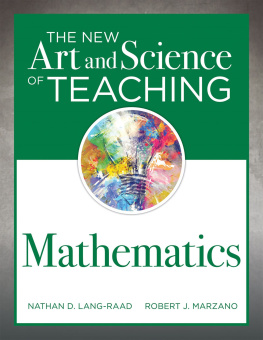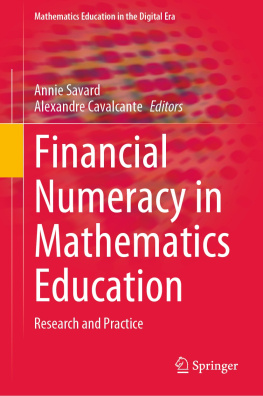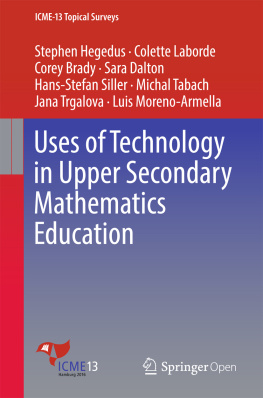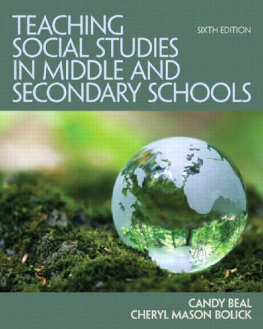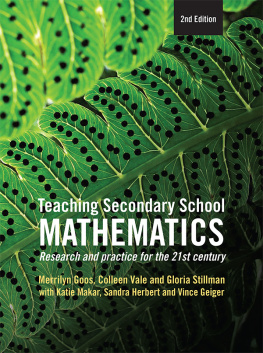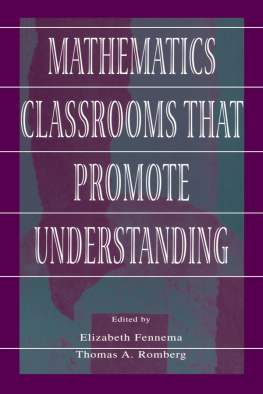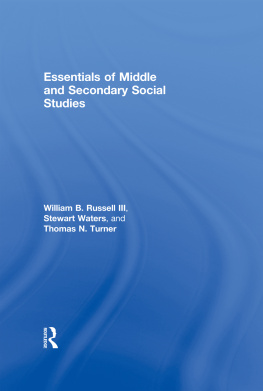Cover
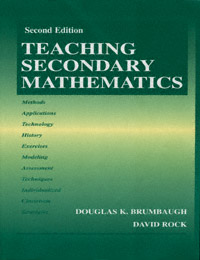
| title | : | Teaching Secondary Mathematics |
| author | : | Brumbaugh, Douglas K.; Rock, David |
| publisher | : | Lawrence Erlbaum Associates, Inc. |
| isbn10 | asin | : | 0805835997 |
| print isbn13 | : | 9780805835991 |
| ebook isbn13 | : | 9780585385068 |
| language | : | English |
| subject | Mathematics--Study and teaching (Secondary) |
| publication date | : | 2001 |
| lcc | : | QA11.B849 2001eb |
| ddc | : | 510/.71/2 |
| subject | : | Mathematics--Study and teaching (Secondary) |
Page i
Teaching Secondary Mathematics
Second Edition
Page ii
This page intentionally left blank
Page iii
Teaching Secondary Mathematics
Second Edition
Douglas K. Brumbaugh
University of Central Florida
David Rock
University of Mississippi

Page iv
Disclaimer:
This netLibrary eBook does not include the ancillary media that was packaged with the original printed version of the book.
Copyright 2001 by Lawrence Erlbaum Associates, Inc.
All rights reserved. No part of the book may be reproduced in
any form, by photostat, microform, retrieval system, or any other
means, without the prior written permission of the publisher.
Lawrence Erlbaum Associates, Inc., Publishers
10 Industrial Avenue
Mahwah, New Jersey 07430
Cover design by Kathryn Houghtaling Lacey |
Library of Congress Cataloging-in-Publication Data
Brumbaugh, Douglas K., 1939
Teaching secondary mathematics / Douglas K. Brumbaugh, David Rock.2nd ed.
p. cm.
Includes bibliographical references and index.
ISBN 0-8058-3599-7 (pbk. : alk. paper)
1. MathematicsStudy and teaching (Secondary). I. Rock, David, 1964 . II. Title.
QA11.B849 2001
510'.71'2dc21 00-056194
CIP
Books published by Lawrence Erlbaum Associates are printed on acid-free paper,
and their bindings are chosen for strength and durability.
Printed in the United States of America
10 9 8 7 6 5 4 3 2 1
Page v
Contents
Preface to First Edition | vii |
Preface to Second Edition | xi |
Dedication | xiii |
About the Authors | xv |
Part I: General Fundamentals | |
1 Introduction | |
2 Learning Theory, Curriculum, and Assessment | |
3 Planning | |
4 Skills in Teaching Mathematics | |
Part II: Mathematics Education Fundamentals | |
5 Technology | |
6 Problem Solving | |
7 Discovery | |
8 Proof | |
Part III: Content and Strategies | |
9 General Mathematics | |
10 Algebra I | |
11 Geometry | |
Page vi
12 Algebra II and Trigonometry | |
13 Pre-Calculus | |
14 Calculus | |
15 Probability and Statistics | |
Author Index | |
Subject Index | |
Page vii
Preface to First Edition
This book is the result of the urging of former students, teachers, colleagues, and friends of Doug Brumbaugh to put his Secondary Mathematics Methods course at the University of Central Florida into print. It is designed to make you, a future teacher of mathematics, think. We have used an informal writing style in order to maintain a dialogue with you. We want to be talking with you, not to or at you.
We assume you will think about and do the problems, questions, and activities as you read through this book. Our intent is to have you begin thinking about your future classroom now. We do not expect you to accept all of our ideas, but we do anticipate that you will react to them and, in the process, begin formulating your own teaching style.
As we created this book, several undergraduate mathematics education majors voluntarily read the manuscript. We incorporated their suggestions. They liked the style and practical approach. They appreciated the fact that they could see a variety of theoretical bases revealed throughout the text. We opted to take an eclectic approach to the learning theories as opposed to stressing any single one. Our assumption is that your teacher will emphasize an approach or preference. Between your teacher and this text, you should be more able to make an informed decision about how you will approach your professional teaching career.
We assume that you will have had some prior exposure to general learning theory and educational methods. This text is designed to build on those, coupled with experiences, specializations, and preferences of your teacher. We provide a collection of examples in a variety of environments. They are designed to furnish you with a broad base of ideas that will stimulate the formative development of thoughts and models you will employ in your classroom.
The text is organized into three parts: General Fundamentals, Mathematics Education Fundamentals, and Content and Strategies. The General Fundamentals (chaps. 14) assume some formal background in courses designed to provide a broad overview of education, curriculum, learning theory, discipline, planning, and adolescent behavior. Our chapters are intended to refresh your memories, provide a basis for discussion that will lead into specifics related to the teaching of mathematics, and motivate you to begin thinking about how you can become an effective teacher of mathematics at the secondary level.
The Mathematics Education Fundamentals (chaps. 58) are designed to be more specific. Here we begin dealing more directly with topics out of the general education environment. Each chapter deals with a subject that will permeate your instruction. We encourage you to plan thoroughly long before you cover any topic with your class. As you plan, you need to think of how you will incorporate technology, problem solving, discovery, and proof into your lesson.
The Content and Strategies section (chaps. 914) builds on the General Fundamentals and Mathematics Education
Page viii
Fundamentals. We assume you will discuss these issues in the class using this text. This final section is designed to capitalize on those discussions and on the expertise and preferences of your teacher. It will provide you with models of how concepts typically found in a secondary math ematics curriculum can be delivered so all students develop a positive attitude about learning and using mathematics in their daily lives.
Next page

